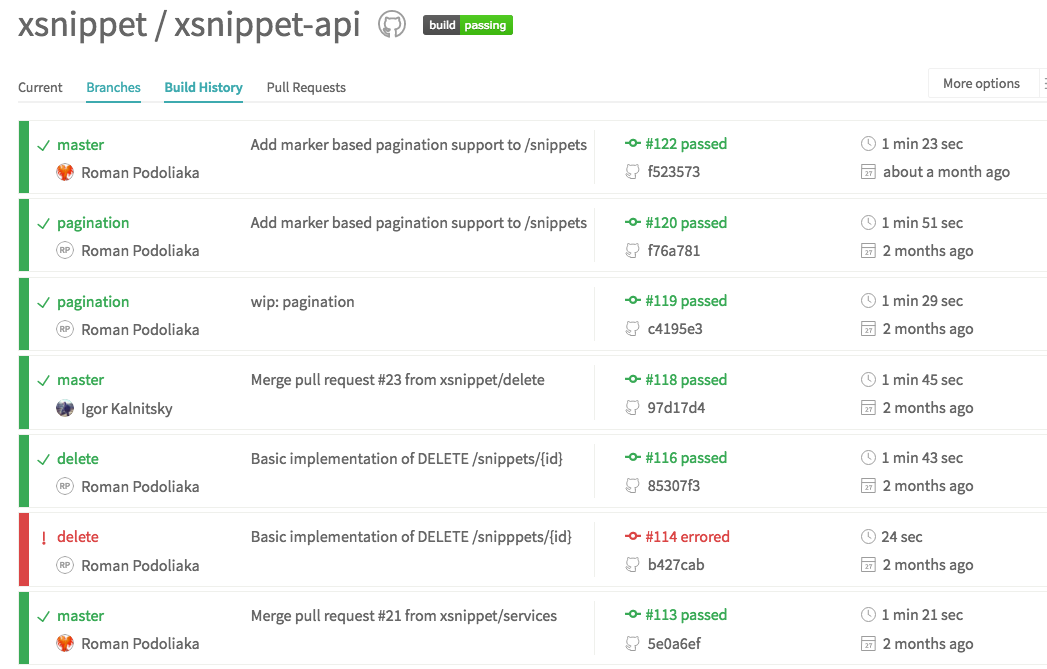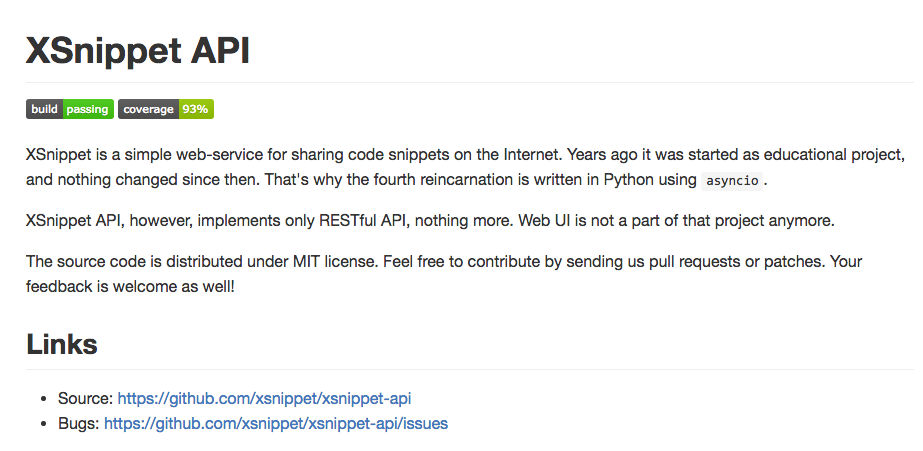Python automated testing 101¶
by Roman Podoliaka (roman.podoliaka@gmail.com)
Kharkiv, May the 12th of 2016
Why automate your test cases?¶
(open source) projects do not necessarily have dedicated QA engineers
projects are (usually) complex and time of engineers is precious
regression testing
test driven development
Automated testing¶
Test cases are usually written by software engineers:
Unit (individual functions or classes)
Integration (modules or logical subsystems)
Test cases are usually written by QA engineers:
Functional (checking a program against design specifications)
System (checking a program against system requirements)
Case study: binary search¶
def binary_search(arr, key):
return _binary_search(arr, key, 0, len(arr))
def _binary_search(arr, key, left, right):
if left >= right:
return
middle = left + int((right - left) / 2)
if arr[middle] == key:
return middle
elif arr[middle] < key:
return _binary_search(arr, key, left, middle)
else:
return _binary_search(arr, key, middle, right)
A test case example¶
import unittest
class TestBinarySearch(unittest.TestCase):
def setUp(self):
super().setUp()
self.empty = []
self.arr = list(range(10))
def test_empty_arr(self):
self.assertIsNone(binary_search(self.empty, 42))
def test_key_not_found(self):
self.assertIsNone(binary_search(self.arr, 42))
suite = unittest.TestSuite()
suite.addTests([TestBinarySearch('test_empty_arr'),
TestBinarySearch('test_key_not_found')])
unittest.TextTestRunner().run(suite)
.. ---------------------------------------------------------------------- Ran 2 tests in 0.003s OK
<unittest.runner.TextTestResult run=2 errors=0 failures=0>
(.venv3)Romans-Air:code malor$ py.test -v binary.py
== test session starts
platform darwin -- Python 3.4.3, pytest-2.9.1, py-1.4.30, pluggy-0.3.1 -- /Users/malor/.venv3/bin/python3.4
cachedir: .cache
rootdir: /Users/malor/Dropbox/talks/autotesting/code, inifile:
collected 2 items
binary.py::TestBinarySearch::test_empty_arr PASSED
binary.py::TestBinarySearch::test_key_not_found PASSED
== 2 passed in 0.05 seconds
coverage: measuring of test coverage¶
coverage provides reporting on what lines of code have actually been executed
allows you to understand which parts of the code are covered by tests and which are not
test coverage is a measurable and comparable metric: a high test coverage value is required (but not enough) to make sure code works as expected
(.venv3)Romans-Air:code malor$ coverage report -m
Name Stmts Miss Branch BrPart Cover Missing
-------------------------------------------------------
binary.py 23 3 8 3 81% 18, 22, 40, 17->18, 19->22, 39->40
[tox]
envlist = pep8,py27,py35
[testenv]
deps = pytest
pytest-cov
commands = py.test binary.py --cov --cov-append
[testenv:pep8]
deps = flake8
commands = flake8 binary.py
(.venv3)Romans-Air:code malor$ tox
___________________________________________________________________ summary
pep8: commands succeeded
py27: commands succeeded
py35: commands succeeded
congratulations :)
CI (continuous integration)¶
testing is only efficient, if it's enforced (e.g. so that one can't "forget" to run the tests)
CI is intended to automate all the required build steps, including testing
CI can (and should) be run in "gating" mode: a commit can not be merged, if tests fail
Travis CI¶
a third-party CI system, that is easily integrated with GitHub
free of charge for open source projects
declarative configuration stored in a repo
sudo: false
language: python
python: 3.5
services:
- mongodb
install:
# greenlet is needed to submit concurrency=greenlet based coverage
# to coveralls.io service
- pip install tox coveralls greenlet
script:
- tox
after_success:
- coveralls
notifications:
email: false



Jenkins¶
a comprehensive solution for CI/CD
a number of plugins for automation of builds steps
number #1 choice when you need a custom CI
can be configured declaratively by the means of Jenkins Job Builder

<?xml version='1.0' encoding='UTF-8'?>
<project>
<actions/>
<description></description>
<logRotator>
<daysToKeep>7</daysToKeep>
<numToKeep>-1</numToKeep>
<artifactDaysToKeep>-1</artifactDaysToKeep>
<artifactNumToKeep>-1</artifactNumToKeep>
</logRotator>
<keepDependencies>false</keepDependencies>
<properties/>
<scm class="hudson.scm.NullSCM"/>
<canRoam>true</canRoam>
<disabled>false</disabled>
<blockBuildWhenDownstreamBuilding>false</blockBuildWhenDownstreamBuilding>
<blockBuildWhenUpstreamBuilding>false</blockBuildWhenUpstreamBuilding>
<triggers class="vector"/>
<concurrentBuild>false</concurrentBuild>
<builders>
<hudson.tasks.Shell>
<command># Move into the jenkins directory
cd /var/lib/jenkins
#Add all top level xml files.
git add *.xml
# Add all job config.xml files.
git add jobs/*/config.xml
# Add all user config.xml files.
git add users/*/config.xml
# Add all user content files.
git add userContent/*
# Remove files from the remote repo that have been removed locally.
COUNT=`git log --pretty=format: --name-only --diff-filter=B | wc -l`
if [ $COUNT -ne 0 ]
then git log --pretty=format: --name-only --diff-filter=B | xargs git rm
fi
# Commit the differences
git commit -a -m "Automated commit of jenkins chaos"
# Push the commit up to the remote repository.
git push origin master
</command>
</hudson.tasks.Shell>
</builders>
<publishers/>
<buildWrappers/>
</project>
- common-sync-params: &common-sync-params
# Branches to sync (see also short names below)
upstream-branch: 'stable/mitaka'
downstream-branch: '9.0/mitaka'
fallback-branch: 'master'
# Branch short names for jobs naming
src-branch: mitaka
dst-branch: 9.0
# Syncronization schedule
sync-schedule: 'H 3 * * *' # every day at 3:XX am, spread evenly
# Gerrit parameters
gerrit-host: 'review.fuel-infra.org'
gerrit-port: '29418'
gerrit-user: 'openstack-ci-mirrorer-jenkins'
gerrit-creds: 'a4be8c41-43e0-4269-94d8-53133cfe3ae5'
gerrit-topic: 'sync/stable/mitaka'
name: 'sync-{name}-{src-branch}-{dst-branch}'
jobs:
- 'sync-{name}-{src-branch}-{dst-branch}'
Useful links¶
Travis CI - CI as a service, that is easily integrated with GitHub
Test Driven Development - a book on TDD by Kent Beck
Understanding the OpenStack CI System - a blog post on OpenStack CI internals by Jay Pipes
Summary¶
“If it’s not tested, it’s broken.” (Monty Taylor)
test coverage is an important metric, but it's not the only one - use common sense!
writing tests is not always fun, but it makes your life easier
Travis CI is a good start, but sometimes a more complex or just custom configuration is needed - this is where Jenkins shines
Thank you!
Slides: http://podoliaka.org/talks/
Your feedback is welcome: @rpodoliaka or roman.podoliaka@gmail.com